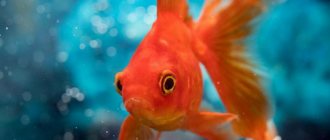There is no limit to the variety of catfish. These fish, depending on their size and character, can be added to almost any aquarium: both with peaceful and aggressive inhabitants. Many catfish, in addition to their external beauty, bring undoubted benefits. Some of them clean plant leaves and decorations from unwanted algae, some collect food debris from the bottom, preventing the water from spoiling. We have selected the most popular and favorite catfish among aquarists.
Ancistrus (Ancistrus sp.)
Ancistrus is perhaps the most common aquarium catfish! Belongs to the chain catfish family. The homeland of these fish is Brazil, the Amazon River. Ancistrus are unpretentious and cute. They have a strongly flattened body in the horizontal plane with a suction cup mouth, with which the fish “scrape off” algal fouling. Classic color grey-black. Orange, brown, spotted and other variations have been bred through selection. A distinctive feature of the fish is the growths on the head of males - “beards” - which appear at puberty. Females and young animals do not have such outgrowths.
Ancistrus reach a size of about 13 cm and live for about 7-10 years. They are great for community aquariums with peaceful fish! Suitable volume – from 50 liters.
Reproduction of ancistrus in a home aquarium is possible. The fish spawn in ceramic tubes, and the offspring are then cared for by the male.
Useful tips
Over more than a century of keeping speckled corydoras in captivity, aquarists have accumulated a lot of knowledge about the care and breeding of these fish.
What else beginners need to know:
- When buying ready-made food, be sure to pay attention to the date of manufacture. Otherwise, you can easily purchase an expired product.
- Store all feed in a sealed form to prevent the development of pathogenic flora.
- If the fish become lethargic, lose their appetite, or have abnormal bowel movements, change their diet - most problems arise precisely because of poor nutrition.
- If the aquarium does not have sufficiently intense aeration, the catfish develop oxygen starvation.
- Loss of appetite and changes in color intensity in fish can be caused by temperature disturbances.
- If a speckled catfish is covered with white spots, this means that it has experienced a stressful situation.
Speckled Corydoras (Corydoras paleatus)
Speckled Corydoras is a medium-sized, peaceful, unpretentious catfish. Belongs to the armored catfish family. The homeland of fish is the waters of America. Corydoras lead a bottom-dwelling lifestyle. They are timid and modest and feel comfortable in a flock.
The Corydoras has a barrel-shaped body, expressive eyes and a small mouth bordered by mustaches on its head. The color of the speckled corydoras is gray with a dark spot, or as it is called “pepper and salt.” Selective breeding has produced species with orange, green, black, white and other colors. Catfish grow 5-7 cm. They are excellent for aquariums with the most peaceful and small fish with a volume of 30 liters or more. Corydoras happily eat leftover food from the bottom.
These fish are spawning fish and reproduce at home without much difficulty. For these purposes, it is better to use a spawning aquarium.
Nutrition
Feeding catfish is even simpler than keeping them. If your pets live in a tank with other fish, then you don’t have to feed the catfish at all - they will happily pick up leftover food from their neighbors, at the same time cleaning the area. When keeping only catfish fish, you can offer your wards the following products:
- Live and frozen food: bloodworms, tubifex, cyclops, shrimp, etc.
- Catfish tablets and flakes.
- Plant foods: cucumber, spinach, green peas, broccoli, etc.
Before serving, live food must be thoroughly washed, and plant food must be scalded with boiling water. If a predatory catfish lives in the tank, you should remember that small neighbors can become its lunch.
Interesting fact: hungry and predatory catfish living in their natural environment can drag even a dog to the bottom.
Brocade pterygoplichthys (Glyptoperichthys gibbiceps)
Pterygoplicht brocade is a large catfish that is a favorite of aquarists. Grows up to half a meter. Belongs to the chain catfish family. In nature, it lives in the waters of South America. Pterygoplichthus has a horizontally flattened body and a “suction cup” mouth on its pointed head. In a calm state, the fins of the fish are pressed to the body. When moving around the aquarium or when excited, the pterygoplicht opens its fins, displaying a luxurious “sail” - the dorsal fin. The color of the fish is brown with spots.
Brocade pterygoplicht is suitable for keeping large and medium-sized fish in aquariums from 200 liters. As a rule, it is not aggressive towards neighbors of another species, but it shows intolerance and territoriality towards its relatives.
Fish do not reproduce at home.
Maintenance and care
The aquarium catfish, no matter what species it belongs to, is an unpretentious fish. But taking into account species characteristics is necessary. First of all, this is the size of the aquarium. Many catfish do not exceed 7 cm in length, but there are half a meter long, giants by aquarium standards. That is, a modest household volume is suitable for some, while others will need a multi-cube dwelling.
Otherwise, the fish have similar requirements. For large and small catfish, the presence of shelter is important. These are driftwood, stones, ceramic pots and the like. The substrate is coarse sand or pebbles. No small fractions, otherwise the catfish, digging in the soil, will muddy the water. The water temperature can vary between 22-28 °C.
In other parameters there are no extremes: weak or moderate hardness and neutral acidity. Catfish, as benthic inhabitants, do not need bright light. Water flow, aeration and regular addition of fresh water are necessary for all inhabitants of the aquarium, including catfish.
Small fish and large catfish can be mistaken for food
Synodontis sp.
Synodontis is an inhabitant of the Zaire River in Africa. Belongs to the fringed catfish family. An unpretentious, medium-sized fish with a bright appearance. Synodontis has an elongated, slightly rounded body. On the head are large eyes and a small mouth, bordered by three pairs of beautiful mustaches. The color of the fish is brown with dark spots. It grows up to 25 cm and lives up to 7-10 years.
Synodontis is a nocturnal resident; during the day, these fish hide in shelters. An aquarium with a volume of 100 liters or more with a large number of different decorations is suitable for them. Neighbors for synodontis should be chosen that are proportionate and active. Catfish will perceive small fish as food.
Natural reproduction does not occur in synodontis at home.
Kinds
Several classification families contain species of aquarium catfish , from the order Catfish. Strictly speaking, a person can create the conditions and maintain most of them at home. Limitations are imposed by the size of the fish. In addition, aquarists single out the most outlandish of all.
Cirrus catfish
All catfish included in this family group originated from Africa. Imitating the Latin name of the family - Mochokidae - they are often called mochokids or mohawks. The family of these interesting fish includes 9 genera and about 200 species. Cirrus aquarium catfish look elegant and exotic in the photo.
- Changeling catfish. The fish prefers to swim with its belly up most of the time. For which it received its name (lat. Synodontis nigriventris). As befits pinnate catfish, the changeling has three pairs of antennae. The dimensions allow you to keep the changeling in any aquarium: it does not grow more than 10 cm. The coloring is camouflage in nature: the general gray-brown background is enlivened by dark spots.
Changelings calmly swim belly up
- Sidontis veil. This species (Synodontis eupterus) loves to swim upside down no less than its fellow changeling. The fins of this fish are not only large, but also spiny. In case of danger, the veiled catfish begins to bristle them, counting on the fact that there are few hunters to chew the spines.
- Cuckoo catfish. Catfish from the genus Synodontis or Synodontis. The fish is often called spotted synodontis. The common names are associated with the abundance of dark contrasting spots on a light background and the habit of nesting in accumulations of alien eggs. This large fish (up to 27 cm) comes from Lake Tanganyika.
- Pymelodus pictus. The name of this fish is a transliteration of its Latin name Pimelodus pictus. The fish has many more nicknames: pimelodus angel, pictus cat, painted pimelodus. The abundance of names indicates the popularity of this 11-centimeter fish from the Amazon basin.
- Synodontis clown. The scientific name of this catfish is Synodontis decorus. In a free state, it lives in the tributaries of the Congo River. Peace-loving and shy despite its decent size. It can grow up to 30 cm. It moves slowly, but the fins, dorsal and caudal, are highly developed. The first ray of the dorsal fin extends into a long thread. This, together with the spotted coloring, gives the fish an unusual appearance.
- Sidontis domino. Large dark dots on a light body caused aquarists to associate it with a game bone, which is why Synodontis notatus received its domino name. Sidontis domino does not tolerate being around other catfish. It can stretch up to 27 cm. Fish farmers recommend keeping only one such catfish in an aquarium.
Catfish successfully take root in almost all bodies of water
- Sidontis marble. Lives in the slow waters of the Congo and its tributaries. Scientists call it Synodontis schoutedeni. The color in the form of streaks of various tones on a yellow background, peaceful nature and moderate length (up to 14 cm) make this fish a good aquarium resident. The only thing is that the marble sidontis protects its territory from encroachment by relatives and prefers to live alone.
- Sidontis angel. The scientific name of this fish is Synodontis angelicus. But another popular name suits the catfish better: polka-dot sidontis. Light spots are scattered across its dark gray-blue body. A native of central Africa, it lives in home aquariums alone or in a small group. This sidontis grows up to 25 cm, which imposes requirements on the volume of its home.
- Spotted sidontis. The names of aquarium catfish often contain an indication of the color and appearance of the fish. The light body of this sidontis is dotted with large round spots. The fish is unpretentious, but quite large: 30 cm is not a small size for an aquarium of any size. But the spotted sidontis lives for a long time - about 20 years.
- Striped sidontis. Originally from Congolese Lake Molebo. The yellow body of this fish has thick, brown, longitudinal stripes. Which are interspersed with spots of the same color. The striped catfish gets along well in the company of its own kind, but is not burdened by loneliness. The length of the catfish is 20 cm, this dictates the corresponding volume of the aquarium (minimum 100 l).
Bagrus family or killer whale catfish
The extensive family (lat. Bagridae) of catfish fish consists of 20 genera, which include approximately 227 species. The fish are native to Africa and Asia. They are not found north of the Amur River. Their elongated bodies are devoid of scales; mucus performs protective functions.
- Bagrus is black. Originally from Indochina, grows up to 30 cm or more. In addition to its large size, it has another drawback - this fish is aggressive. Loves to jump. Can leave the aquarium without a lid in no time. He knows how and loves to swim backwards. Included in the biological classifier under the name Mystus leucophasis.
- Bagrus glass or patterned. Unlike its black brother, this is a very small fish. Up to 5 cm including caudal fin. Trying to become invisible, the catfish became transparent. How on the screen of an X-ray machine you can see its insides, and in females preparing for spawning, ripening eggs.
- Spearcatfish. The name comes from the shape of the dorsal fin. The first ray of which is significantly elongated. A contrasting almost white stripe runs along the dark body. Perhaps it gave rise to scientists’ associations with a spear. Endemic to the island of Sumatra. The catfish is small, grows up to 20 cm, but has a hot temper.
- Mistus two-point. Originally from the island of Sumatra. Small in size (up to 6.5 cm) catfish. In the front part of the light body, closer to the head, a fat, dark spot is drawn. The foretail is emphasized by a dark, almost black stripe. The aquarium population can be diversified with one or more catfish due to their peaceful nature.
Almost all catfish have whiskers, ranging from very long to barely noticeable
- Catfish batasio. Originally from Thailand. This fish does not exceed 8 cm. Modest size corresponds to modest coloring. In youth, the body color is pink, after two months of age, it begins to turn brown. The general background is crossed by wide dark stripes. Batazio is peaceful and unpretentious. Scientists call it Batasio tigrinus.
- White-haired catfish. The body is painted in deep dark tones, with light mustaches standing out against this background. Because of this, Bagrichthys majusculus received the common name “white-whiskered”. A native of Thailand, it grows up to 15-16 cm. Unpretentious, like all Asian catfish. Males strictly guard their territory. Females are more docile and peaceful.
- Siamese catfish. The name of the fish is associated with its place of birth - Siam, present-day Thailand. Recalling its family affiliation, aquarists often call it the Siamese killer whale or orca. The Siamese catfish has a number of advantages: elegant, unpretentious, easy-going, with optimal sizes (up to 12 cm).
Family of armored catfish
Some species of this family are popular inhabitants of the lower floors of aquarium waters. Aquarists are well aware of the catfish that belong to the genus Corydoras. The body of these fish is covered with horny scales. This circumstance gave the name to the genus Corydoras and the entire family - armored catfish or Callichthyidae.
- Pygmy catfish. Originally from South America. In its natural state it lives in streams flowing into the Madera River. The length of the largest specimens does not exceed 3.5 cm. The body of the pygmy is relatively higher than that of other catfish. It hides less and actively moves in all layers of the aquarium.
- Leopard catfish. Inhabitant of Colombian rivers and reservoirs. Reaches Guyana and Suriname. The body of the fish is dotted with spots, but there are three longitudinal stripes on the sides. This is why it is often called the three-lined catfish. Its scientific name is Corydoras trilineatus. The catfish is small (no more than 6 cm), gets along well with its neighbors in the aquarium.
- Catfish Panda. Inhabitant of mountain tributaries of the Amazon. Accustomed to soft and relatively cool water. The temperature of 19 °C does not frighten him. It is pampered in aquariums and prefers 20-25 °C. On the light body of the catfish there are two large spots near the head and tail. The fish is peaceful, prefers life in the company of 3-4 similar pandas.
Corydoras pandas must be kept in an aquarium with sandy soil to avoid damage to the lower antennae
- Brohis britski. This catfish has a more understandable name - emerald catfish or emerald corydoras. The scientific name of the fish is Corydoras britskii. Endemic to the Brazilian Paraguay River. Grows up to 9 cm. Feels comfortable in a group of 3-5 relatives. Decorates the aquarium with the colors of its body: from orange to green.
- The corridor is armored. The fish comes from Peru. Scientific name: Corydoras armatus. The armored scales acquired the character of armor. The first rays of the fins are hard and look like spines. Body color is white with dark speckles. The character of the fish is peaceful. 5 or more armored corydoras can live in one aquarium.
Pimelod catfish
This family (Pimelodidae) has another name - flathead catfish. The largest inhabitants of aquariums. Their bodies are devoid of scales. The length of the whiskers can reach the length of the body. These creatures with a flattened head are predators, but are not aggressive in temperament. They are often kept in office and club multi-ton aquariums.
- Aquarium tiger catfish . One of the most compact pimelod species. It grows up to 50 cm. Dark tiger stripes are drawn along the light body of the catfish. The fish are kept in very large aquariums, next to proportionate neighbors. Small fish are eaten by catfish, although they cannot be called aggressive.
- Redtail catfish. Large fish with spectacular color. In a free state, it lives in the tributaries of the Amazon. Living in a spacious aquarium, it can reach a meter in length. That is, it will not be possible to contain it in even large containers at home.
Under natural conditions, red-tailed catfish can grow up to 80 kg.
Another large catfish - the cherished dream of owners of very large aquariums - is the shark catfish . The aquarium resident is attractive because it resembles the famous predatory fish. In terms of eating habits, it is not much different from her. Tries to eat everyone who can fit in its mouth.
Chain catfish
The family has a second name: loricariid catfish or Loricariidae. This is one of the largest fish groups. The family includes 92 genera and more than 680 species. Only some species of loricariids have taken root in aquariums.
- Plecostomus or aquarium catfish stuck . This species was the first ringed catfish to become established in home aquariums. His name has become a household name. All loricariid fish are often called plecostomus or sticky catfish. It feeds on aquarium greens and eats everything that grows on the walls of the aquarium and stones.
During daylight hours, catfish prefer to hide under snags and other shelters
- Ancistrus jellyfish. The fish's birthplace is the Brazilian Tocantins River. Scientific name: Ancistrus ranunculus. It has a very unusual appearance: the catfish’s mouth has outgrowths that resemble tentacles. This moving beard is tactile sensors. They gave the catfish a name and made it a desirable resident of home aquariums. The catfish grows to no more than 10 cm. It has a peaceful character, although it prefers animal food.
- Ancistrus vulgaris. The homeland of catfish is Patagonia, the Rio Negro basin. The fish is omnivorous, large enough for home aquariums, can grow up to 20 cm. The coloring is strict and elegant at the same time: there are many small white dots on a dark background, the fins are emphasized by a white border.
Very unpretentious catfish stick, but it is best to keep them in large aquariums
- Whiptail catfish. Its second name is catfish sucker Acestridium or Acestridium dichromum. The homeland of the whiptail is Venezuela, small tributaries of the Orinoco. An elongated fish with a flattened head. The length does not exceed 6 cm. The tail stem with the fin resembles a lash or whip. With its characteristic suction cup mouth it scrapes lower algae from the walls of the aquarium. But this is not enough to feed the fish. Additional green food is required.
- Zebra pleco. System name Hypancistrus zebra. One of the most attractive catfish, residents of home aquariums. The outfit consists of alternating dark and light contrasting stripes. Originally from Brazil, rivers and streams flowing into the Xingu, a tributary of the Amazon. The fish is omnivorous, can be predatory, but is quite peaceful. Grows up to 8 cm.
Otocinclus
Otocinclus is a little worker of the home aquarium! Belongs to the chain catfish family. In nature, it lives in the waters of South America. Otocinclus has an elongated body, slightly flattened in the horizontal plane, with a “suction cup” mouth. The fish are not bright, most often gray-white in color. They grow about 5 cm.
Otocinclus is distinguished by its hard work: all day long, catfish clean the leaves of plants (without damaging them!) and decorations. Otocinclus are friendly, great for aquariums with the smallest inhabitants: nano-fish and shrimp. In addition, they live well in flocks. The required volume for these catfish is from 30 liters.
Otocinclus can easily reproduce at home.
Reviews
There are no negative reviews about speckled catfish. It’s not for nothing that they are among the TOP most popular fish, because they suit aquarists in all respects.
Nikolay P., aquarist with 5 years of experience. I have several aquariums, I keep different fish, but I recommend that everyone definitely get speckled corydoras. Firstly, these catfish are small and do not need a lot of water, and secondly, they are hardy - if the filter or aerator suddenly breaks, no tragedy will occur - the fish will be saved by intestinal respiration and swallowing air from the surface. And finally, catfish help me clean the aquarium, they don’t fight, they’re beautiful, and they’re interesting to watch.
Liliya M., amateur aquarist. I bought one catfish for the first time. He lived in an aquarium with neons and a yellow snail. He was bored alone, and he did not communicate with other fish. Soon the catfish got used to it, began to float to the top, swallowed air and flew to the bottom like a bullet. At first I thought I was sick, and then I read that this was a common thing for Corydoras. Now I keep speckled catfish in schools - it’s more fun for them, and it’s more interesting for me to watch them.
It is not for nothing that the speckled catfish is included in the ranking of the most popular aquarium inhabitants. This fish is beautiful in all respects - it has expressive colors, has interesting behavior, is hardy, reproduces easily and, in addition, maintains order in the aquarium.
Platydoras costatus
Platidoras is a catfish that has long been loved by aquarists and belongs to the armored family. The homeland of this fish is the waters of Brazil and Peru. Platydoras has an elongated, slightly flattened body with a rounded head and a mouth with sensitive whiskers. Dorsal and pectoral fins with hard, jagged first rays. The color is bright: black and gray with horizontal milky stripes. Platydoras grows about 20 cm.
This catfish is a typical nocturnal hunter. During the day it hides in shelters and is active at night. An aquarium of 100 liters or more with nimble, proportionate neighbors is suitable for it.
Platydoras do not reproduce at home. In fish farms, catfish receive injections of hormones necessary for procreation.
Pimelodus pictus
Pimelodus angelfish is a bright, contrasting catfish belonging to the Pimelodidae catfish family. In nature, it lives in Paraguay and Brazil. Pimelodus has an elongated silver spotted body with large eyes and luxurious long mustaches. Fish grow up to 20-30 cm.
An aquarium with a volume of 200 liters or more with plenty of hiding places is suitable for them. Pimelodus can live in a flock, they look luxurious! Proportional and active residents can be recommended as neighbors for these fish.
Pimedolus angels do not reproduce at home.
Glass Indian catfish (Kryptopterus bicirrhis)
The glass Indian catfish is a small, peaceful, exotic-looking catfish from the true catfish family. The homeland of these fish is the waters of India, Thailand, and Sri Lanka. The glass catfish has an elongated, laterally flattened body, with large eyes and a pair of long whiskers located on its pointed head. The scales and skin of the fish are pigmentless, so the body of the catfish is transparent! Because of this, the spine is clearly visible. Behind the head of the catfish there is a small silver “bag” - this is a cavity in which all the internal organs of the fish are located. The dorsal fin is missing. Indian catfish grow up to 10-12 cm.
A common aquarium with peaceful inhabitants with a volume of 30 liters or more is suitable for them. Catfish live mainly in the lower third of the aquarium. They are timid and modest, preferring a flock of their own kind. Indian glass catfish look great in aquariums overgrown with greenery!
These fish have not reproduced in captivity.
Diseases
As soon as the fry hatches, it can be fed with very fine food: cyclops, brine shrimp larva, microworm, or branded food ground into dust. It is important to keep the water clean with regular water changes.
Fin rot
The disease is characterized by paleness, inflammation and fraying of the fins. Sometimes blood streaks appear on their surface. The reasons for this condition may be unsatisfactory quality of water and food, overcrowding of the aquarium, stressful situations, as well as the development of other diseases.
For treatment, antibacterial drugs should be used, for example, tetracycline and chloramphenicol. For prevention purposes, it is necessary to regularly change the water, measure its temperature, not give the fish too much food, and also not to overpopulate the aquarium.
Swim Bladder Disorder
A condition in which the abdomen becomes very distended, causing the fish to swim upside down. This disease is caused by overeating or excess air. In such situations, it is recommended not to give the fish food for two to three days, and after this period to feed it with a small amount of pea porridge.
To improve the digestive process, you should slightly increase the temperature of the water in the aquarium, and, on the contrary, reduce its level. Prevention involves maintaining perfect cleanliness in the aquarium, correct dosing of food, and pre-soaking food.
Pangasius sanitwongsei
Pangasius highfin - or shark catfish, a beautiful and large fish native to the waters of Asia. Belongs to the Pangasiidae catfish family.
Externally, pangasius resembles a shark: a swift body, a high dorsal fin, and a large mouth. The color is dark gray with a light belly. Pangasius grows up to 3 meters. Juveniles of this fish are successfully kept in aquariums. Suitable volume – from 500 liters. Despite their impressive size, pangasius are shy. It is necessary to always keep the lid of the aquarium closed - this catfish can easily jump out if there is a sudden noise or movement. When decorating an aquarium, you should avoid sharp objects - pangasius swim in the water column and can get hurt.
At home, these catfish do not reproduce.
Reproduction and lifespan
There are many varieties of aquarium catfish. Most of them successfully produce offspring catfish in artificial conditions. The impetus for the beginning of the reproduction process is the combination of certain factors. The presence of roofs is a general condition. A suitable temperature and an influx of fresh water is an impetus for the fish to prepare for spawning.
The female lays up to half a million eggs. The spawning platform is the substrate or leaf of an aquatic plant. Catfish do not show concern for future offspring. Acts of cannibalism are possible. Incubation lasts several days. After which the larvae appear.
There are a lot of species of aquarium catfish, each with its own reproductive characteristics. Amateur aquarists have not mastered the process of obtaining offspring from more than half of the catfish species. Young animals are produced on fish farms, creating special conditions and using hormonal drugs.
Catfish caught in the natural environment are often supplied to the retail trade. Regardless of origin, caution and a high level of adaptability have made many catfish long-lived. No other fish can live as long as aquarium catfish live Large specimens surpass the 30-year mark.
Sturisoma panamense
Sturisoma panama is an unusual type of catfish belonging to the chainmail family. Lives in water bodies of South America. Sturisoma has an elongated, thin rod-like body with a thickening near the head and abdomen. The muzzle is long, with a “lower” mouth. The caudal fin ends in filamentous outgrowths. The color of the fish is brown with a pattern. Sturisoma looks great in an aquarium overgrown with greenery! The fish grows up to 20-25 cm.
The suitable volume for Panamanian sturisoma is from 150 liters. This fish feels comfortable in the company of calm, friendly neighbors.
At home, sturisomes reproduce without problems.
Prices
In pet stores the price tag is higher, on bulletin boards it’s cheaper.
| Size(cm) | Starting price (Russian rubles) |
| Up to 2.5 | 55 |
| 2.5–4 | 75 |
| 4–5 | 90 |
| 5–8 | 180 |
| 8–11 | 200 |
| 11–15 | 250 |
| 15–18 | 300 |
| 18–20 | 400 |
| 20–25 | 500 |
| More than 25 | 1000 |
Fractocephalus (Phractocephalus hemioliopterus)
Fractocephalus or red-tailed catfish is a large predator from the pimelodaceae family. Fractocephalus is native to the Amazon.
The catfish has a dense, powerful body with a flattened head and a huge mouth bordered by three pairs of whiskers. The color of the fish is contrasting: gray-white with orange edging on the caudal and dorsal fins. Fractocephalus grow more than a meter and feed on everything that fits into their mouth. In this regard, among their neighbors only proportionate, active fish are suitable. The required aquarium volume for red-tailed catfish is from 300-500 liters. It is advisable to use dim lighting and driftwood as decoration. All items in the aquarium should be securely fastened to avoid injury to the fish.
Fractocephalus does not reproduce at home.
How to choose catfish
Catfish are very diverse both in nature and in the aquarium. But when buying a specific species, you need to have a good idea of its size as an adult, habits and features of keeping.
Dimensions and physical shape
Moreover, the size of catfish is one of the most important indicators. The same red-tailed catfish, for example, is often found on sale with a size of 5-8 cm and attracts attention with its bright decorative coloring. But how many are ready for the fact that he can grow up to 1.4 meters and reach a weight of 45 kg?
It is also necessary to pay attention to the appearance of the fish. Many of them may seem quite thin. This is normal - when transporting fish, they feed very little. But the stomach should not look very sunken.
The coloring of catfish should be uniform and bright, the skin should be smooth and free of plaque, and the fins should be intact.
Particular attention should be paid to the antennae of these fish. They should not bleed or be shortened. This is a sign of poor maintenance, in which the catfish’s whiskers are the first to suffer.
Behavior
If you plan to add catfish to other fish in a community aquarium, you need to study their habits. Even outwardly similar catfish can be either peaceful or more aggressive. And we must not forget that many of them are predators, including those capable of swallowing fish larger than their size.
How to distinguish a female from a male
Female catfish are larger in size and have a rounded abdomen. Males are brighter and more variegated in color, have larger fins and a greater number of growths and antennae.
Near the anus, males have a protruding tubercle, and females have a depression.
Transportation home
Usually fish are transported in plastic bags with water. But it is better to transport aquarium catfish in double bags, and large species even in triple bags. They often have sharp spines on their fins that can easily pierce a bag. Better yet, use plastic containers.
Thoracatum (Megalechis thoracata)
Torakatum is a medium-sized and relatively peaceful catfish from the armored family. Its homeland is the reservoirs of South America.
The thoracatum has an elongated, rounded body with a narrowed head, on which there is a small mouth with two pairs of whiskers. The color of the fish is gray-brown with spots. They grow up to 20 cm. Torakatums are unpretentious and are great for beginners. These fish feel comfortable in a school. They need a volume of 60-100 liters. In the aquarium, it is desirable to have dim lighting and a large number of hiding places: thoracatums, like many catfish, are crepuscular inhabitants, hiding during the day and being active at night.
At home, these fish reproduce.
Compatibility
Most representatives of catfish, due to their friendly and peaceful nature, get along well with their relatives and other aquarium fish. Modest and quiet, catfish do not enter into conflicts or start fights, but with the wrong neighbors they can become victims. Introducing predatory fish, for example, astronotus, into the same aquarium together with catfish can lead to the death of the latter. It is also not recommended to place small and weak fish - guppies, neons and others - in a tank with predatory catfish, since pets may consider them food.
Interesting fact: the European catfish can weigh up to 400 kg, and is even capable of attacking people.
Red loricaria (Rineloricaria sp.)
Red Loricaria is an elegant, peaceful and very cute catfish from the chainmail family. Lives in the Amazon River.
Loricaria has a thin, long body with a slight thickening in the area of the head and abdomen. On the upper edge of the caudal fin there is a thread-like outgrowth, which gives the fish even more charm. The color of the catfish is brick-red. It grows up to 15 cm. Loricaria looks luxurious against the background of the greenery of the aquarium! This fish is suitable for community aquariums with calm and friendly neighbors. The required volume for it is from 50 liters.
At home, loricaria reproduce without difficulty.
Panaque nigrolineatus L190
Royal black-lined panak is a beautiful, stately catfish from the chainmail family. The homeland of the Panacs is the Orinoco River in South America. The catfish has a horizontally flattened body covered with reliable armor. On the pointed head there are large eyes and a “suction cup” mouth. The royal panak has a contrasting gray-brown or gray-black color. The fish grows up to 30 cm (in nature up to half a meter).
Panakas are territorial and intolerant of members of their own species. Panakas get along well with other medium-sized fish, especially those occupying the middle and upper third of the aquarium. An aquarium of 200 liters or more with a large amount of natural driftwood as an additional source of food is suitable for them.
Reproduction of panakas at home is difficult, primarily due to the size of the fish and aquariums.











